Kimeblog // By Tony Mikla
Meet Aaron Crouch, DPT – KIMEU Kettlebell Resilience Instructor
September 17, 2024
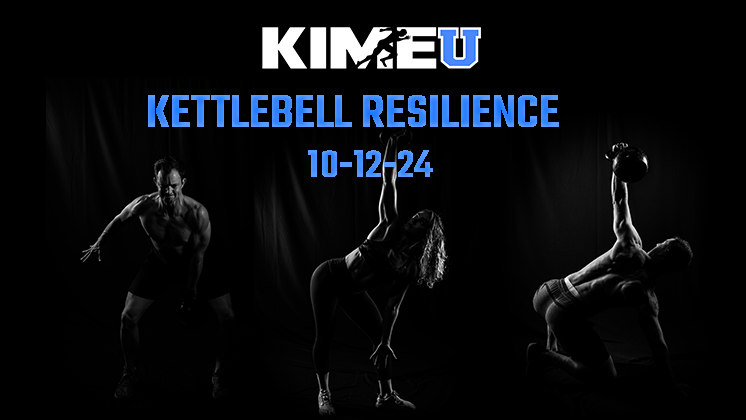
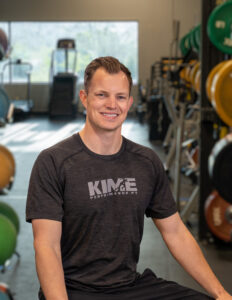
Dr. Aaron Crouch might be the personified manifestation of KIME’s mission:To improve lives through movement, inspire hope, and impact the health and well-being of every client by providing the best care through integrated clinical practice, performance enhancement, education, and research.
A former NCAA Division I baseball player, Aaron turned a season-barring injury into a curiosity and commitment to help fellow and future athletes not only beat their obstacles, but exceed their sports performance expectations. Through his role as Foothill Regional Director, Physical Therapist, and Performance Coach, he’s able to mentor clients and fellow colleagues with a specialized knowledge that’s informed by a history of studied and practiced cross-training, consisting of speed, strength, and flexibility.
He also spearheads KIME’S Kettlebell Resilience course, a rendition that was created to be a further adaptation of his, Russ’s, Tony’s, and Evan’s experience at StrongFirst. As Aaron explains, “StrongFirst is an international kettlebell company that offers training for people that want to certify themselves a specific way of using the kettlebell. We felt we had a great experience, but we also felt there were some holes. We wanted to make it in house and we wanted to incorporate more coaching. I took the charge of instructing the course for our team, as well as [for] external people that also might want to test themselves in the particular ways that we do with the kettlebell.” Complete with a long list of certifications, Aaron utilizes KIME as a vessel to improve the sports medicine space, whether it be through his advising to fellow therapists or his training with a variety of clientele. Below, he shares insights on his experience with KIME, the physical therapy industry, and what it takes to make a truly impactful impression on your team and people seeking to improve, recover, and inspire.
What initially sparked your interest in physical therapy, body movement, and body care? When did you know that it was the kind of work that you wanted to pursue?
I think like many, an initial interest came from my athletic background and involvement in sports. I played multiple sports growing up, and played baseball into college, which is probably where it first started. I had plenty of injuries over my time playing sports, and I’d say the most impactful one that kind of sent me down the path of physical therapy was once I was in college. I had one particular injury that derailed me for an entire season. It was little less about the injury that really sparked my interest, but it was more of the process that I had in order to get back on the field, which was most important to me.
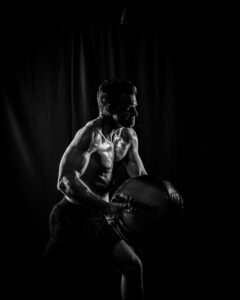
I didn’t have a lot of clarity on what the injury specifically was, how long it would take to heal, or what I needed to do at each and every step along the way to ensure I was going to return to baseball at the time as fast as I could. I feel like there was a lot of mismanagement in my experience, which ultimately drove me once I pivoted from an athletic focus to an academic and career path focus. It drove me in my “why” of why I wanted to be a PT, because I don’t want that to be the experience of anyone that I treat, certainly the young athlete that has this really small, sensitive time window of competing and being in something they are really passionate about. [Injury recovery] is a simple thing to be clear about and to have a plan and a process for. So I chose physical therapy. So, the sports medicine route made sense to me and that’s how I discovered the physical therapy route.
For the movement side of things, I feel like I’ve put myself through a lot of different training stimuli. The typical training strategy for a young athlete or even a college athlete is done for power, speed, and strength. Once I got done with playing my sport, I pivoted to half-marathon training, which could, could not be any different or further from what I was doing before. That was mostly just a competitive outlet for me once I got done playing. In retrospect, that was a nice choice, [at the time I didn’t know] I was developing my aerobic system. From there is when I started going a bit back to strength and the kettlebell became a nuanced tool I’d never used before and so I was intrigued by that. I was able to adapt and be quite flexible in my capabilities.

How did you become involved in KIME? As regional director, a physical therapist, and a performance coach, what does your day to day work life look like?
I joined KIME because, well–my mission in PT school never deviated from wanting to be in sports medicine, so that I could serve in the way I wanted to from my own personal experience. In the relative industry of physical therapy, it’s very common for people to work in khakis and polos–I absolutely despise that. It just drives me nuts. You can’t move your body, and if you’re teaching exercise or doing plyometrics or whatever else, you can’t do it with a tucked in shirt and Sperry’s. That was a weird subcategory of need, that I didn’t have to wear that stuff.
In PT school, I really thought I was going to work for a professional baseball team. That’s what I was going to do. And I actually kind of went out of my way and set up a clinical rotation with the San Francisco Giants at their minor league facility in Arizona to get that experience. I’m glad I did because it was awesome, a great learning moment, but definitely not quite the same picture that I envisioned.
Around that same time in PT school, around year two of three, I got connected with Tony and Russ on LinkedIn. In the early part of his career, Tony had given us a talk at one of my undergrad classes, so I remembered him and some of the things that he said. He reached out and obviously noticed a few things that I had been doing in my background and invited me to come visit their new operation up in El Dorado Hills.
I remember he took me out to the gym floor and he was working with a track athlete at the time. From a performance standpoint, they were doing very familiar things to what I was used to doing. And it felt very comfortable, I felt very at home. I didn’t need to have a long conversation about pay or benefits or anything else like that. I just–he wasn’t wearing khakis, that was a key indicator. He also described where they were at, their mission, and their vision and what they want to do, to kind of change the industry. It really spoke to me. I didn’t really need to listen to anyone else after that. So, I joined right out of PT school which was great.
I think my initial experience, or my whole experience, really kind of alludes to why I have so many different titles. My brain does really well when I’m constantly stimulated, or doing a variety of things.
From the beginning of joining KIME I was kind of acting like a business owner, and one without a whole lot of resources. I remember scheduling patients via my phone, taking checks or cash by hand, texting people–it was very startup-esque. Looking back on it, it was a really powerful experience for me. It felt like I had a lot of autonomy and a lot of control and a lot of freedom in what I wanted to do. As the company’s grown and I’ve been part of that, new roles have surfaced. I took the regional director role at KIME because of my experience and my interest not only in trying to set out on the mission that I set for myself, but for each individual person I treat. Also with the mission of KIME, I can almost scale myself and be around people with shared missions and help them get to the point where I am.
As for Performance Coach, I labeled myself that because I can flex between being a rehab specialist that will help someone in a pain state, surgical rehab state all the way through. And if they want to talk about how they prepare for an Olympic event or get faster, get stronger, get more powerful, improve their athletic capabilities–I continually learn nuances to human performance. I put a lot of time on my own personal learning with podcasts and books, and the constant repetition of treating people and training people that I feel I can flex both skills.
I think every PT should. I feel like by sometimes demonstrating that capability with people around me, they maybe will see themselves as being able to do the same, without me telling them they should.
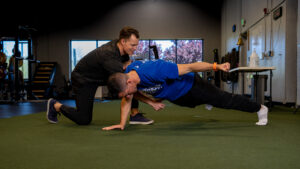
You have a wide range of clients, from people who want to be able to go through everyday life without being in pain to high performance, highly competitive athletes who are determined to be the best. What does that require from the staff? What does that exchange of energy look like, and how does it feel to be around that group of people?
It requires flex. Recently this last week, I had one patient who was a nine-year NFL running back veteran at one half hour, and then the next person coming in was in their 70s, who wants to live an independent, fruitful life. So to be able to flex your mind and your approach in that single hour can be tremendously difficult if you don’t have a rooted framework of thinking. I’ve learned that it requires a consistent approach and a confident thought process in regards to how the body functions. Everyone falls on the same spectrum, it’s just a matter of whether you’re going to dial it up or dial it down, as far as the intensity and the focus. I learned that really early.
I will honestly say I came out of school highly unprepared to be in this setting and I could not be more grateful for having people like Tony and Russ as mentors, and my buddy Evan as a peer that pushes the needle, as well as continually having teammates around us that push the needle. I feed off that, and it’s helped me create a more sound approach, more consistent approach with each and every person I treat. If someone older comes in to see me, I’m not going to somehow change to a really soft, gentle–I mean, I’m empathetic with every single person, but for me, I’ve become highly interested in everyone’s longevity, their health span rather than their lifespan. I place a similar amount of energy and focus into someone that’s 60, 70, 80 years old as I do that young athlete that wants to be the best version of themselves in their sport. I think it’s really common for us to get candidates that come in and say, “Oh, I want to work with athletes.” That’s great, they are a fun group to work with, and they require you to flex your mind quite a bit, but at the same rate, you’ll apply the same energy and effort to every single person that comes in willing to put in work to try to be better at something. What it takes is a fair amount of dedication to the craft, filling all the gaps in how to develop or progress and regress human performance and apply it to the appropriate intensity for the right person.
For a lot of people, an injury can be very emotional and personal. What’s it like to get into that mentorship space to appropriately be there for a client?
That’s definitely the soft art of what we do, and I would say most of what we do. You could be the biggest expert of the nuts and bolts on human performance, in all the exercise, or mobility, or whatever, but if you cannot connect with the person across from you–either to know what makes them tick personally, or what their true “why” is, or how to speak to them in a certain way–because everyone is motivated in a different way–I don’t know if that’s tangible. That is definitely a huge aspect of anyone’s success, especially as myself or any other PT or coach as the guide, you have to really connect with the person. It’s an exercise progression and rehab is not hard. What’s hard and what’s different is every single person comes in at a different mental space. Breaking down those layers of guardedness or apprehension is the true task at the beginning. Then, once you have their trust and know each other on a relatively personal level, then you can make meaningful change. Then there’s got to be a moment where you have to grind a bit, and it might bother some things, but if they have that trust in you, they’ll follow.
Whether it be from the San Francisco Giants, or Olympic track and field, or SFMA, how do you apply your past experience to your clients and roles at KIME?
I will say being a college athlete really taught me about what the body can handle on a physical level, with a very personal experience of physical change. It’s powerful because you know how much work it takes to actually get change, from either muscle growth or healing. There’s a variety of applications, but I would say the first one that gave me a lot of lessons was being an actual athlete.
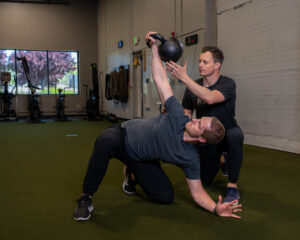
Being with the Giants gave me a perspective of what a high level athlete and mover looks like. That’s the same thing for the track and field championships that I’ve worked with early on too. With a client, we’re obviously responsible for teaching them whatever the skill is they want to learn to achieve their goal–it’s what’s most important. So, if I get a kid that comes in and we’re going through a dynamic warmup, or sprinting form, from previous experience, I’ve seen it at the highest level. It helps me understand what that person’s version should look like, or at least should somewhat resemble. I’m not going to make a 13-year-old try to look like a track athlete, but if [their form] is sloppy, or if I know they have more in them and I know what the perfect version looks like, and they’re not even close, I’m going to tell them that. If I’m not satisfied with that level of performance, nor should they be. I think seeing those high level events helps me hold people to a higher standard. That might sound kind of mean, but they also want to be held to a higher standard because they want the most out of their experience, too.
The SFMA was more of a learning experience.The SFMA stands for the Selected Functional Movement Assessment, which is more of a movement evaluation tool. What I didn’t get coming out of PT school is a really clean version of how to evaluate someone’s movement. We got special test stuff that you need to pass the licensing exam, which is like roll and rule out certain tissue pathology, but they didn’t really go super deep into diving into someone’s movement deficiencies to get to a root cause of their problem. Which is, in reflection, kind of mind-blowing.
So, the SFMA was my first exposure to that mindset, on acquiring that knowledge. It’s a really intensive two-day course, and you get all the tools, but you’re not an expert in it by any means, so you have to then apply it. I didn’t feel like it was really telling me anything until I applied it at least a hundred times, if not more. I still continually use aspects of it every day. I’ve also been teaching for Rock Tape for six years, which is profoundly impactful to me. I’ve been really lucky to be exposed to a lot of different things and I feel like that all shapes my approach to coaching clients or even then, coaching other PTs. It helps really formulate a strong message.
How do you juggle all of this while making time for yourself, your family, and your own enjoyment?
My wife and I have a really strong relationship and even before kids, that was a highly valued time of mine. It’s certainly enhanced since having kids and my presence in their life and the things that I can model for them is my number one value. A lot of things that I do, I center around my time and my energy with my family. I’ve never needed solo, personal time for me to feel recharged, I guess. I go on runs with some friends, or take my kids out for runs or bike rides. For me, it’s sharing things that I enjoy with them, which is movement and being outside. I just do it in versions that they can tolerate because they’re younger. My balance over the years has come from removing a lot of the nonsense, or time wasters. I’ve eliminated TV in my life so that I can spend more time doing meaningful things. I work hard in the days that I’m in the clinic and then I have Fridays off with my boys, which I feel is a very impactful time for us to connect and do things that we love. As we keep scaling the size of the company, it just means greater and greater impact, and I feel very good about contributing energy to that. It’s not drawing from me, it’s almost energizing me. Working at any time is not perceived as draining for me
Written by Franchesca Baratta
Contact franchescabaratta@gmail.com
Recent Blogs
Archives
Kimecast Channels




